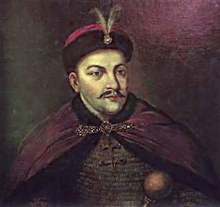- Yurii Khmelnytsky
-
Yurii Khmelnytsky 
Hetman of Ukraine In office
August 27, 1657 – October 21, 1657Preceded by Bohdan Khmelnytsky Succeeded by Ivan Vyhovsky In office
October 17, 1659 – 1663Preceded by Ivan Vyhovsky Succeeded by Pavlo Teteria (as Hetman of Right-Bank Ukraine), Ivan Briukhovetsky (as Hetman of Left-Bank Ukraine) Hetman of Right-bank Ukraine In office
1678–1681Preceded by Petro Doroshenko Succeeded by Józef Potocki as Voivode of Kiev Voivodeship Personal details Born 1641
Subotiv, near Chyhyryn, Polish-Lithuanian CommonwealthDied 1685
Kamianets-Podilskyi, Podolia Eyalet, Ottoman EmpireReligion Greek Orthodox Church Yurii Khmelnytsky (Polish: Jerzy Chmielnicki, Russian: Юрий Хмельницкий, Ukrainian: Юрій Хмельницький) (1641–1685), younger son of the famous Ukrainian Hetman Bohdan Khmelnytsky and brother of Tymofiy Khmelnytsky, was a Zaporozhian Cossack political and military leader. Although he spent half of his adult life as a monk, he also was Hetman of Ukraine on several occasions — in 1659-1660 and 1678–1681 and starost of Hadiach.
Contents
Biography
Hetman of Ukraine
Yurii Khmelnytsky was born in 1641[1] in Subotiv near Chyhyryn in central Ukraine. In 1659 the Cossack Rada elected 17-year-old Yurii as their hetman in Bila Tserkva instead of deposed Ivan Vyhovsky. The young hetman was faced with the uneasy alliance with Tsardom of Russia and the ongoing wars against Poland-Lithuania and the Crimean Khanate.
In 1659 he was granted nobility by parliament (sejm walny) of Polish–Lithuanian Commonwealth.[1] On 24 March 1661 he became starost of Hadiach.[1]
During the latter conflict, Yurii Khmelnytsky's Cossacks were defeated near the town of Korsun, he was captured by the Poles and later pledged loyalty to king Jan II Kazimierz. This provoked a civil war within Ukraine in 1661, when the new ataman Yakym Somko led the pro-Moscow Cossacks against Yurii and his new Polish allies. At the battle near the town of Pereiaslav in the Summer of 1662 Yurii Khmelnytsky was defeated by Somko's Cossacks and the Russians under Grigory Romodanovsky.
After the defeat, Khmelnytsky entered an alliance with the Crimean Khanate but this resulted in little beyond massive looting and raiding of Ukrainian towns and villagesby the Tatars. Thereupon Yurii gave up his hetman title and became a monk at the Mharsky Monastery in the autumn of 1662. Between 1664 and 1667 he was imprisoned in Lviv by hetman Pavlo Teteria.
Hetman of Right-bank Ukraine
After his release, in 1672 he participated in a campaign against the Tatars and was captured near Uman and brought to Constantinople, where he was allowed to live in a Greek Orthodox monastery. In 1676 — after the Sultan's ally, Petro Doroshenko, surrendered to the Russians — the Porte decided to use Khmelnytsky's famous name to reinforce their claim to the Right-bank Ukraine starting the Russo-Turkish War (1676–1681).
In 1678 the Turkish army captured Chyhyryn and declared Yurii Khmelnytsky as a new hetman of Ukraine, although in reality he was only a puppet for the Ottoman Sultan. Ottoman Turkish army with Yurii in tow captured and burned down Kaniv and other Ukrainian towns. He then retired to his Sultan dictated capital at Nemyriv in Turkish occupied parts of Ukraine, as a vassal of sultan Mehmed IV until 1681, when the Turks removed him from power due to his unstable mental health and unprecedented cruelty. Two years later, he was briefly re-instated by the Poles. Finally in 1685 the Turks captured Yurii and executed him (strangled[1]) in Kamianets-Podilskyi.
Unlike his father, Yurii was unable to master the very complex situation he faced and was often manipulated by foreign powers.
Notes
- ^ a b c d Boniecki, Adam (1900). Herbarz polski. 3. Gebenther & Wolf. p. 8. http://ebuw.uw.edu.pl/dlibra/doccontent?id=134.
Preceded by
Bohdan KhmelnytskyHetman of Ukraine
1657Succeeded by
Ivan VyhovskyPreceded by
Ivan VyhovskyHetman of Ukraine
1659–1663Succeeded by
Pavlo TeteriaPreceded by
Petro DoroshenkoHetman of Ukraine
1678–1681Succeeded by
uncertainSee also
- Hetmans of Ukrainian Cossacks
- List of Ukrainian rulers
References
Hetmans of Ukrainian Cossacks Registered Cossack Army Przecław Lanckoroński · Ostap Dashkevych · Dmytro Vyshnevetsky · Ivan Svyrhovsky · Ivan Pidkova · Ivan Oryshevsky · Bohdan Mykoshynsky · Krzysztof Kosiński · Hryhoriy Loboda · Severyn Nalyvaiko · Petro Konashevych-Sahaidachny · Mykhailo Doroshenko · Taras Fedorovych · Ivan Sulyma · Dmytro Hunia ·
Cossack Hetmanate Bohdan Khmelnytsky · Yuriy Khmelnytsky · Ivan Vyhovsky · Yuriy Khmelnytsky
Left-bank Ukraine Ivan Bezpalyi · (acting hetman) · Yakym Somko · (acting hetman) · Ivan Briukhovetsky · Demian Mnohohrishny · Ivan Samoylovych · Ivan Mazepa · Pylyp Orlyk · Ivan Skoropadsky · Pavlo Polubotok · (acting hetman) · Danylo Apostol · Kyrylo Rozumovsky
Right-bank Ukraine Pavlo Teteria · Petro Doroshenko · Yuriy Khmelnytsky · Mykhailo Khanenko
Categories:- 1641 births
- 1685 deaths
- People from Cherkasy Oblast
- Hetmans of Ukrainian Cossacks
- People of the Russo-Polish War 1654-1667 (Russian side)
- Executed Ukrainian people
- People executed by the Ottoman Empire
- Alumni of the National University of Kyiv-Mohyla Academy
- 17th-century executions
Wikimedia Foundation. 2010.
